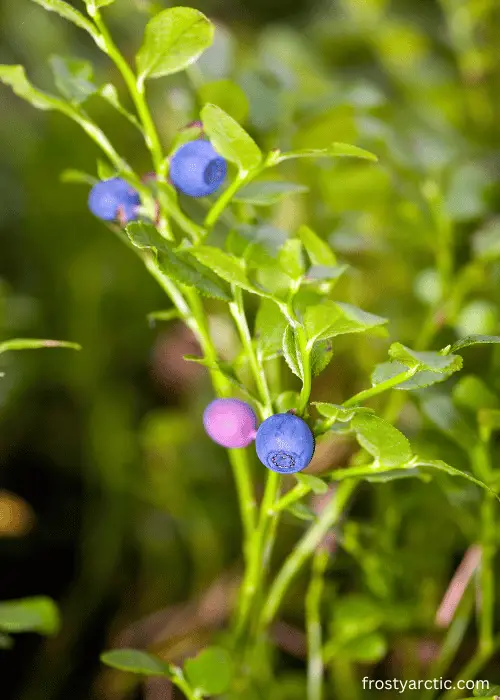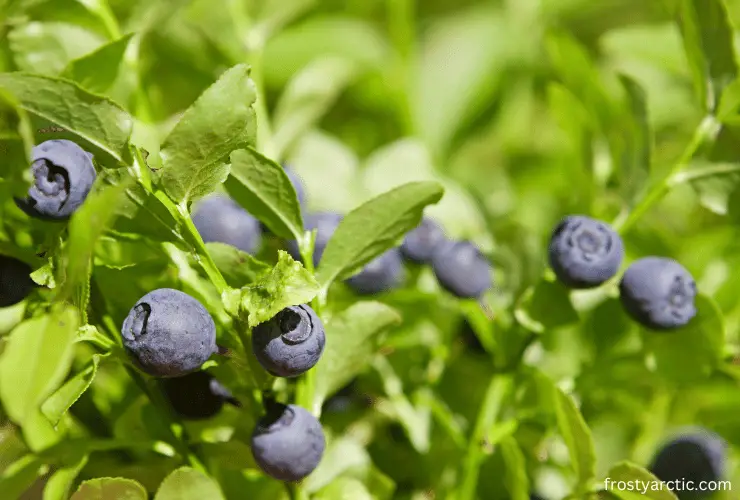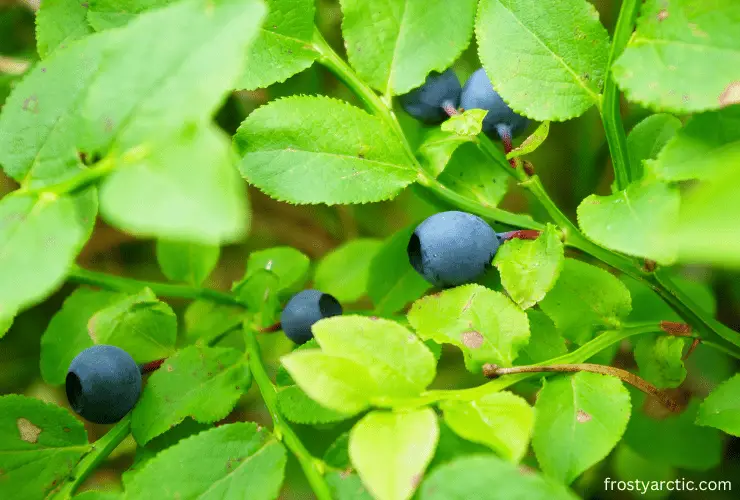Bilberry is one type of perennial shrub that normally blooms from April to July and bears fruits like berries. They like to grow in cool climates and acidic soil. But the fruits lack acidity, which makes them medium sweet.
Throughout this article, I will discuss every detail of this plant as well as its benefits. If you are fond of fruits like berries, read the article till the end to learn everything about Bilberries.
Bilberry At a Glance
| Parameters | Description |
| Scientific name | Vaccinium myrtillus |
| Plant type | Perennial |
| Plant size | 10-40 cm |
| Leaf size | 1-2 inches |
| Width | ½ inches |
| Soil condition | Acidic |
| Watering | Normal |
| Sun exposure | Full |
| Leaf color | Green |
| Flower color | Greenish |
| Blooming season | April to July |
| Toxicity | No |
| Uses | Medicinal |
What is a Bilberry?
Bilberries are low-growing shrub that belongs to the family Ericaceae. The scientific name of the bilberry is Vaccinium myrtillus, and often, people call the plant “European blueberry.” In general, Bilberry is one kind of plant that you will normally find in Eurasia.
Bilberry plants produce dark blue and round-shaped berries that look like blueberries. This plant is most common in arctic regions. Normally, Bilberry plants grow slowly.
However, different types of people know it by different names. The other most famous names of bilberry are whortleberry and huckleberry. They are wild shrubs, and you can cultivate them at home.
Why Is It Called Bilberry?
The black cranberries of this plant are already referred to by their scientific name, Vaccinium, in Virgil. The name came from the archaic Greek word “vakintos,” also known as hyakintos which means blue flower hyacinth. The Latinized term was applied to a blueberry, specifically the black cranberry.
The name bilberry comes from the Danish term “bollebar,” which describes the fruit’s intense color (dark berry). Bilberry is frequently referred to as a “superfood.”
Where Does Bilberry Grow?
Bilberry typically grows on acidic soil. Acidic soil with pH 3.8-5.5 is the best condition for the growth of this bilberry shrub. The optimum pH value for the growth is 4.5.

Its natural habitat is heaths, shrubs, and subalpine pastures, which are always damp and have a high pH. It is a type of shrub that likes to establish significant populations.
However, the Vaccinium myrtillus plant grows throughout North America and Eurasia. In Italy Vaccinium, you will find it in the north and center of the mountains.
How Do You Identify Bilberry? [Appearance]
You can identify the bilberry plants by observing their physical characteristics. Bilberries and blueberries may be similar looking from the outside. Here I will mention the physical factors that will help you quickly identify the bilberry plants:
- Height: The plant height is generally shorter compared to others. Typically, it can rise to 10 to 40 cm.
- Flowers and fruits: The flowers are fused, 4 to 6 mm long, and shallowly 4 to 5 lobed. They are greenish and yellowish-reddish. A single carpel and 4 or 8 stamens are produced. The axils contain solitary flowers.
The fruit’s shape is spherical, normally 6-8 mm broad. Generally, the fruits appear with dark blue color. Sometimes, you may notice shiny black fruits appear. On the other hand, the color inside the fruits is red.
- Leaves: The leaves are short-stalked and alternately arranged. The leaf blade is bright green, elliptic-ovate, tapering, and sharply serrated.
- Stem: The stem of this plant is woody. Besides, the stems are branched abundantly. The brown color appears on the older stems, and the younger ones are green.
Bilberry Adaptations
This fruit plant mainly grows well in forests and heaths. To adapt to their natural habitat environment, this plant evolved a lot. Here are some of the adaptations of Bilberry:
- Root: The bilberry has a fibrous root system with shallow root distribution. The root can absorb the essential nutrients from the soil for proper growth.
- Leaves: The leaves of these plants are green. They continuously produce food through the photosynthesis process with the help of sunlight.
- Moisture Retention: This plant has shorter size of leaves. As a result, it loses less amount of water through the transpiration process.
- Short height: Being a short-height plant, it has several advantages. For example, this short size of plant grows close to the ground, and the harsh wind can’t break the stem.
How Much Sun Does Bilberry Need?
The bilberry is a plant that needs full sun. Insufficient sunlight impacts the growth of flowers and fruits.
Avoid placing your plants next to big trees while choosing a place for them to thrive. Partly shade or full shade will hamper its photosynthesis process.
As a result, the growth of Bilberry will slow down. In addition to reducing air circulation and affecting light, the tree crown coverage increases the likelihood of infections.
But avoid the plants from getting heavy sunlight. It’s because, under constant heat, the plants may burn out.
The cell of leaves can get damaged or may lose moisture through evaporation. This will eventually affect photosynthesis causing slow growth or death of the plants.
How Do Bilberries Reproduce?
Both vegetative and seed reproduction is possible with bilberries. Vegetative reproduction is known as the asexual reproduction method.
On the other hand, their seed reproduction is, in fact, a sexual reproduction process. Here, I will discuss their reproduction methods:
- Vegetative regeneration: After disruption, various types of vegetative regeneration seem to be the primary importance. However, even in the absence of disturbance, colonies grow laterally due to rhizome development.
Rhizomes will continue to grow new roots while attaching to their mother plants. During this period, it keeps generating new shoots from its nodes. After some time, they detach from their mother plants and grow as individual plants.
- Seeds: Bilberry fruits typically have 18 to 20 viable seeds and 18 average malformed seeds per berry. The average weight of a seed is 25 mg per 100 seeds.
Typically, seed production starts at age three and is highly variable annually. Here, the primary pollinators are bees. Bees pollinate the seeds from one plant to another.
Is Bilberry Edible?
Yes, the bilberries are edible. They are rich in nutrients like other berries. You can eat fresh fruits as well as dried, on their own, as part of any recipe, or by cooking.
As a result, one cup of blueberries should provide about 85 calories, 15 grams of naturally occurring sugar, and 4 grams of fiber (148 grams). They probably contain around 85% water, similar to blueberries, and significant levels of manganese and vitamins C and K.
Bilberry Taste
The taste of bilberries is more potent, fruity, sweet, and tart. They are the ideal berries for your smoothies, shakes, oats, porridge, yogurt, cooking, and baking. In general, their flavor is distinctive, and once you try it, you’ll adore it.
However, the sweet-tasting berries don’t contain much sugar. They are sweet because of their low acid content. You can make bilberry tea from the leaf, and it will taste medicinal and grassy.
Bilberry Has Been Used for Medical Purposes Since The Middle Ages
The plant’s edible components include berries and leaves. In the past, bilberry was used to treat several diseases, such as diabetes, oral inflammation, diarrhea, and urinary issues.
Besides, it has a high vitamin C concentration, and that’s why it has been traditionally used to prevent scurvy. In the time of World War II, it was used to improve night vision.
What Does Bilberry Do for The Eyes?
Bilberry is an excellent medicine for improving the vision of your eyes. Bilberries are rich in anthocyanosides. This nutrient reduces vascular permeability and capillary fragility, which helps to enhance night vision or vision impairments in low light. British fighter pilots took it during World War II to improve their night vision.
Retinal injury, known as retinopathy, bilberry, has been suggested as a possible treatment for the disease. Additionally, it has shown preventive properties against cataracts, glaucoma, and macular degeneration, especially when combined with lutein.
What Animals Eat Bilberry?
Black bears, deer, rabbits, foxes, squirrels, and chipmunks eat the fruits. Besides, they also eat the leaves and twigs too. This can be a good source of food for some mammals and birds.

If you harvest the bilberry, it may sometimes end with disaster as most animals and pets can attack the plants and fruits. The animals like the sweet taste as well as the innate qualities. But too much eating can cause stomach pain to birds and animals.
What Did Native Americans Use Bilberry For?
Native Americans first used it as a food product at the very beginning. But day by day, they discover the health benefits of fruits and leaves. Fruits have a rich amount of healthy nutrients that can treat many diseases. Native Americans mainly treat diabetes and eye problems with bilberries.
Is Bilberry a Medicinal Plant? Medicinal Use of Bilberry
Yes, bilberry is one of the best medicinal plants used for the treatment of various diseases since the Middle Ages. Here I mention some therapeutic use,
1) Improving Vision
The most common use of the bilberries is for the improvement of night vision. It has anthocyanosides that help to improve vision.
The cell rhodopsin is crucial for night vision. Anthocyanosides help in the regeneration of the rhodopsin in the outer segment of the frog rod. This results in a better dark adaptation rate.
But remember, it only enhances natural night vision. Loss of night vision due to any accident or occurrence is not treatable by this plant.
2) Diabetes Control
Bilberry leaves have been used to manage people’s blood sugar levels. Studies indicate that most berries may be helpful in controlling blood sugar levels, especially when combined with oatmeal, but more research is required to confirm this.
Research indicates that most berries help the body’s glucose response after eating a high-sugar meal
3) Treating Diarrhea
For many years, bilberry has been used in European medicine to treat diarrhea. The fruit includes tannins, which have anti-inflammatory and astringent properties that help tighten and constrict tissues. It reduces the diarrhea symptoms by reducing inflammation of the intestinal.
4) Heart Issue
Bilberry has a beneficial effect on your heart. This may be partially due to their high vitamin K content, which lowers your risk of heart attack and stroke by preventing blood clot formation.
What Are the Side Effects of Bilberry?
Generally, the bilberries are considered safe when consumed in. But sometimes, the excessive amount can cause side effects.
- Bilberry has components named tannins. This can cause allergies in your body. You should avoid bilberry if you have an allergic problem.
- It is unknown whether using bilberry supplements in high dosages or for a long time is safe or not. Some experts warn against using significant amounts of supplements made from bilberries since they may have adverse effects.
- Sometimes, you may feel nausea when you take excessive amounts of bilberries.
- Increase the acidity in your stomach
FAQs
What is bilberry good for?
Bilberry is good for many diseases, such as diarrhea, diabetes, cancer prevention, heart issues, and eye problems. Bilberries are mostly famous for improving night vision due to a nutrient called anthocynosides.
Who should not take bilberry?
Bilberry has some side effects. Considering these side effects, people with an allergy, pregnant women, and people with low blood pressure should not take this.
Are bilberries the same as blueberries?
No, bilberries are not the same as blueberries. The bilberries may look like blueberries, but they have some unique distinguishing factors that you can identify bilberries and blueberries.
Is bilberry good for weight loss?
Yes, bilberry can help you to lose weight. It has an anti-inflammatory effect that contributes to weight loss. Besides, they contain special flavonoids, which also can help with this issue.
Conclusion
Bilberry or Vaccinium myrtillus is an evergreen plant that benefits human life beyond the thinking level. From the beginning of the discovery of this plant, it has been used as a medicinal plant till now.
You can cultivate this little shrub in your home in your garden. But make sure that whether any animals attack it or not.


